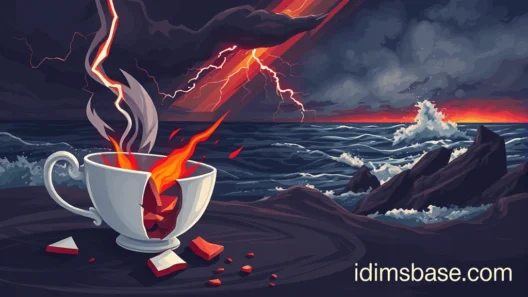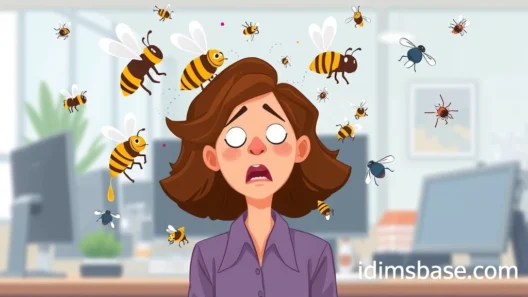Have you ever felt the wind whisper secrets in your ear, or perhaps seen it dance through the trees like a mischievous sprite? Wind, in all its invisible glory, is a truly captivating force of nature. It can be gentle, a soft caress on a summer's day, or it can rage with the power of a thousand storms. No wonder poets, writers, and thinkers throughout history have tried to capture its essence using the magic of metaphors!
Metaphors are like little word paintings. They help us understand one thing by comparing it to something else, often in a surprising and beautiful way. When it comes to wind, these comparisons can be incredibly vivid, bringing to life its many moods and movements. Let's explore 38 amazing metaphors for wind that will surely inspire your imagination and deepen your appreciation for this ever-present element!
38 Metaphors for Wind
Get ready to see the wind in a whole new light! Each of these metaphors offers a unique perspective, highlighting different aspects of its character.
Wind as a Living Being
- Wind is a breath of the earth: Imagine the planet itself exhaling and inhaling. This metaphor conveys the wind's fundamental connection to our world, a vital part of its life force. It’s always there, a subtle reminder of the earth's living presence.
- Wind is a ghostly whisper: Think of a faint, almost inaudible sound that sends shivers down your spine. This metaphor captures the quiet, eerie side of wind, especially when it moves through empty spaces.
- Wind is a playful child: Picture a child running around, full of energy, sometimes gentle, sometimes a bit boisterous. This metaphor perfectly describes the wind's unpredictable, lighthearted nature.
- Wind is a furious beast: When the wind howls and tears through everything in its path, it truly feels like a wild animal unleashed. This metaphor emphasizes its raw power and destructive potential.
- Wind is a silent observer: Sometimes the wind is just there, unseen, unheard, watching everything unfold. It's a subtle background presence, a quiet witness to the world.
- Wind is a tireless dancer: Watch the leaves, the grass, the branches sway and swirl. The wind moves them in a constant, graceful, and sometimes wild, rhythm. It’s always in motion, never still.
- Wind is a mischievous prankster: It can whip off your hat, rustle your papers, or suddenly change direction just to surprise you. This metaphor highlights its unpredictable and sometimes teasing nature.
- Wind is a lonely wanderer: Always moving, never settling in one place. This metaphor evokes a sense of solitude and endless journey, as if the wind is searching for something.
- Wind is a powerful sculptor: Over time, wind can shape mountains, carve out valleys, and smooth stones. It's a patient artist, constantly working on the landscape.
- Wind is a gentle caress: When it's soft and warm, it feels like a tender touch on your skin, comforting and soothing. This metaphor speaks to its ability to bring peace.
Wind as a Force or Tool
- Wind is nature's broom: It sweeps away leaves, dust, and debris, cleaning the air and the ground. This metaphor shows its practical, cleansing function.
- Wind is an invisible hand: It pushes, pulls, and guides things without being seen. Think of sails filling or kites soaring – an unseen force at work.
- Wind is a mighty engine: Powering windmills, driving ships, and generating electricity. This metaphor highlights its immense energy and utility.
- Wind is a tireless messenger: Carrying scents, sounds, and even pollen from one place to another. It's a natural conveyor of information.
- Wind is a forgotten song: Sometimes you hear it moan, whistle, or sigh through the trees, creating a unique melody that feels ancient and evocative.
- Wind is a wild conductor: Orchestrating the rustling of leaves and the creaking of branches, creating a symphony of nature.
- Wind is a whispered secret: When it’s very light, it feels like it’s sharing hushed information, just for you.
- Wind is a roaring lion: In a storm, its sound can be terrifying and powerful, like the king of the jungle asserting its dominance.
- Wind is a sculptor of dunes: It patiently moves grains of sand, creating vast and shifting landscapes.
- Wind is a natural air conditioner: Especially on a hot day, a cool breeze feels like a refreshing blast from a giant cooling system.
Wind as an Abstract Concept

- Wind is time's passage: It moves relentlessly, always forward, never stopping, much like time itself. It reminds us of the constant flow of life.
- Wind is the breath of change: It brings new weather, new scents, and can signal shifts in seasons or moods. It's a harbinger of transformation.
- Wind is a mood swing: One moment it's calm, the next it's blustery, reflecting the unpredictable nature of emotions.
- Wind is freedom's song: It moves unhindered, unbound, symbolizing liberty and the spirit of exploration. It goes wherever it pleases.
- Wind is a forgotten memory: It can stir up old feelings or send shivers down your spine, like a distant recollection.
- Wind is the world's heartbeat: A constant, rhythmic presence that reminds us of the planet's vitality and ongoing existence.
- Wind is unbridled energy: It's pure, raw power, not contained or controlled, just existing in its natural state.
- Wind is a canvas for sound: It carries voices, music, and the sounds of nature, painting an auditory picture of the environment.
- Wind is a fleeting thought: It comes and goes quickly, sometimes leaving a lasting impression, sometimes disappearing without a trace.
- Wind is a restless spirit: Always moving, always searching, never truly at peace. This metaphor hints at an underlying urgency.
More Evocative Metaphors
- Wind is a thief of hats: A classic and humorous metaphor, perfectly capturing its tendency to snatch things away unexpectedly.
- Wind is a gardener's helper: It helps pollinate plants and disperse seeds, aiding in the growth and spread of life.
- Wind is a painter of waves: It creates ripples and swells on the water, constantly changing the ocean's surface.
- Wind is a storyteller: It whispers tales through the rustling leaves, sharing ancient narratives and secrets of the land.
- Wind is a magician's cloak: It can make things disappear and reappear, creating illusions and adding a touch of mystery to the world.
- Wind is a giant's sigh: A deep, resonant sound that suggests something vast and powerful expressing emotion.
- Wind is a cosmic broom: Sweeping through the universe, moving stars and dust, on a grander, unimaginable scale.
- Wind is pure potential: It holds the power to create, destroy, or simply exist, a blank slate of energy waiting to be harnessed.
These metaphors truly show how versatile and inspiring the wind can be. Each one offers a fresh perspective, inviting you to look at this everyday phenomenon with new eyes and a deeper sense of wonder!
Frequently Asked Questions
You've got questions about wind and metaphors? We've got answers! Let's dive into some common queries.
What is a metaphor?
A metaphor is a figure of speech that directly compares two unlike things without using "like" or "as." It says one thing is another to create a deeper meaning or a vivid image. For example, "The wind is a furious beast" means the wind is like a beast in its power and intensity, not just that it behaves like one. It helps us understand complex ideas by relating them to something more concrete or familiar.

Why do writers use metaphors for wind?
Writers use metaphors for wind for several compelling reasons. Firstly, wind is invisible, so metaphors help make it tangible and relatable. They give it personality and form. Secondly, metaphors add richness and depth to descriptions, making the writing more engaging and evocative. They allow readers to "feel" the wind, not just read about it. Lastly, metaphors can convey complex emotions or ideas associated with wind, like freedom, power, or change, in a concise and impactful way.
How can I create my own metaphors for wind?
Creating your own metaphors is fun and a great way to boost your creativity! Here's a simple process:
- Observe the wind: Pay attention to how it sounds, feels, and what it affects. Is it gentle, harsh, consistent, or erratic?
- Think of its actions: Does it push, pull, whisper, roar, dance, or sweep?
- Brainstorm unrelated things that share those qualities: If the wind sweeps, what else sweeps? A broom, a hand, a current. If it roars, what else roars? A lion, an engine, a crowd.
- Make the direct comparison: "The wind is a broom," "The wind is a lion."
- Refine and add details: "The wind is nature's broom," "The wind is a roaring lion in the storm."
The more you observe and connect different ideas, the better your metaphors will become!
Can metaphors be used in everyday conversation?
Absolutely! Metaphors aren't just for poetry or literature. We use them all the time without even realizing it. Saying "He's a wizard with numbers" or "Her smile is sunshine" are everyday metaphors. Using them can make your conversations more colorful, expressive, and memorable. They add a touch of flair to your language.
What's the difference between a metaphor and a simile?
This is a great question! Both metaphors and similes compare two different things, but they do it in slightly different ways.
- Metaphor: States that one thing is another. (e.g., "The wind is a ghostly whisper.")
- Simile: Compares two things using "like" or "as". (e.g., "The wind sounds like a ghostly whisper.")
Think of it this way: a metaphor is a direct statement of identity, while a simile is a comparison of similarity. Both are powerful tools for vivid description!
Key Takeaways
Wow, what a journey through the invisible world of wind! We've seen how a simple natural phenomenon can inspire such a rich tapestry of language and imagery.
- Metaphors make the invisible visible: They give form and personality to the unseen force of wind, helping us connect with it on a deeper level.
- Wind has many personalities: From a playful child to a furious beast, a tireless dancer to a lonely wanderer, the wind embodies a vast range of moods and actions.
- Metaphors enrich language: They add depth, emotion, and vividness to our descriptions, whether in writing or everyday conversation.
- You can create your own! By observing and connecting seemingly unrelated things, you can craft unique and powerful metaphors that truly capture your imagination.
Hopefully, this exploration has given you a fresh perspective on the amazing power of language and the endless inspiration found in the natural world. So, the next time you feel a breeze, stop for a moment. What metaphor comes to your mind? Let the wind whisper new ideas to you!






